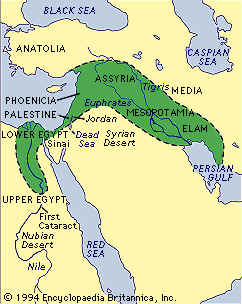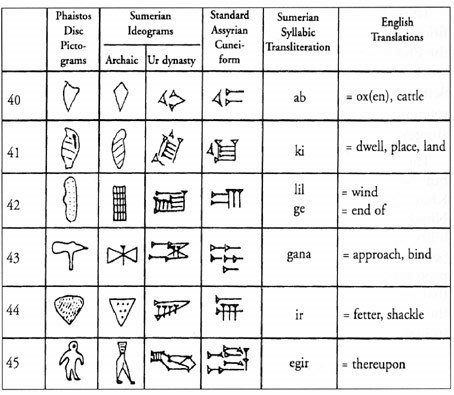
The Sumerians
Hunter-gatherers had roamed that part of the Middle East called the Fertile Crescent, and they had planted gardens. By 7000 BCE the crops they planted became a major source of food. They had begun farming, which required permanent settlement.
By 4500 BCE people archaeologists would call Ubaidians were living in towns in in Mesopotamia (Greek for "between two rivers") near where the Tigris and Euphrates rivers emptied into the Persian Gulf. The Ubaidians drained marshes. They grew wheat and barley and irrigated their crops by digging ditches to river waters. They kept farm animals. Some of them manufactured pottery. They did weaving, leather or metal work, and some were involved in trade with other societies.
By 4000 BCE to the south in Syria a society existed that had regional centers and a complex government. Here, as with the Ubaidians, people baked bread in huge ovens and manufactured fine pottery. In the year 2000 of modern times, at Tell Hamoukar, archaeologists discovered a protective city wall, and they described the place of their digging as more than a town. They described it as a city. And they found primitive hieroglyphics: markings for recording trade transactions. It was around 4000 BCE that a people called Sumerians moved into Mesopotamia, perhaps from around the Caspian Sea.
By 3800 BCE the Sumerians had supplanted the Ubaidians and Semites in southern Mesopotamia. They built better canals for irrigating crops and for transporting crops by boat to village centers. They improved their roads, over which their donkeys trod, some of their donkeys pulling wheeled carts. And the Sumerians grew in number, the increase in population the key element in creating what we call civilization -- a word derived from an ancient word for city.
At least twelve cities arose among the Sumerians. Among them were Ur, Uruk, Kish and Lagash -- Ur, for example, becoming a city of about 24,000 people. In the center of each city was a temple that housed the city's gods, and around each city were fields of grain, orchards of date palms, and land for herding. Besides planting and harvesting crops, some Sumerians hunted, fished, or raised livestock. In addition to an increase in population, civilization was also about variety, and enough food was produced to support people who worked at other occupations -- such as the priesthood, pottery making, weaving, carpentry and smithing. There were also traders, and the Sumerians developed an extensive commerce by land and sea. They built seaworthy ships, and they imported from afar items made from the wood, stone, tin and copper not found nearby.

Writing
Sumerian writing is the oldest full-fledged writing that archaeologists have discovered. The Ubaidians may have introduced the Sumerians to the rudiments of writing and recorded numerical calculation, which the Sumerians used with the rise in trade and to calculate and to keep records of supplies and goods exchanged. The Sumerians wrote arithmetic based on units of ten -- the number of fingers on both hands. Concerned about their star-gods, they mapped the stars and divided a circle into units of sixty, from which our own system of numbers, and seconds and minutes, are derived.
The Sumerians wrote poetically, describing events as the work of their gods, and they wrote to please their gods. The Sumerians wrote by pressing picture representations into wet clay with a pen, and they dried the clay to form tablets. Instead of developing their writing all at once, as one might expect with divine revelation, they developed their writing across centuries. They streamlined their pictures into symbols called ideograms, and they added symbols for spoken sounds -- phonetic letters -- forming what is called cuneiform.
Early in Sumerian civilization, eighty to ninety percent of those who farmed did so on land they considered theirs rather than communal property. Here too the Sumerians were expressing a trend that was common among others. Another individual effort was commerce, and with a growth in commerce the Sumerians had begun using money, which made individual wealth more easily measured and stored. Commerce required initiative, imagination, an ability to get along with people and luck, and, of course, some merchants were more successful than others.
Farmers also benefited from luck, and they needed stamina, good organization and good health. And, as with merchants, some were more successful than others. Those who failed to harvest enough to keep themselves in food and seed borrowed from those who had wealth in surplus. Those who borrowed hoped that their next harvest would give them the surplus they needed to repay their loan. But if the next harvest was also inadequate, to meet their obligations they might be forced to surrender their lands to the lender or to work for him. When Sumerians lost their land, they or their descendants might become sharecroppers: working the lands of successful landowners in exchange for giving the landowners a good portion of the crops they grew.
Common Sumerians remained illiterate and without power, while kings, once elected by common people, became monarchs. The monarchs were viewed as agents of and responsible to the gods. It was the religious duty of their subjects to accept their rule as a part of the plan of the gods. Governments drafted common people to work on community projects, and common people were obliged to pay taxes to the government in the form of a percentage of their crops, which the city could either sell or use to feed its soldiers and others it supported.